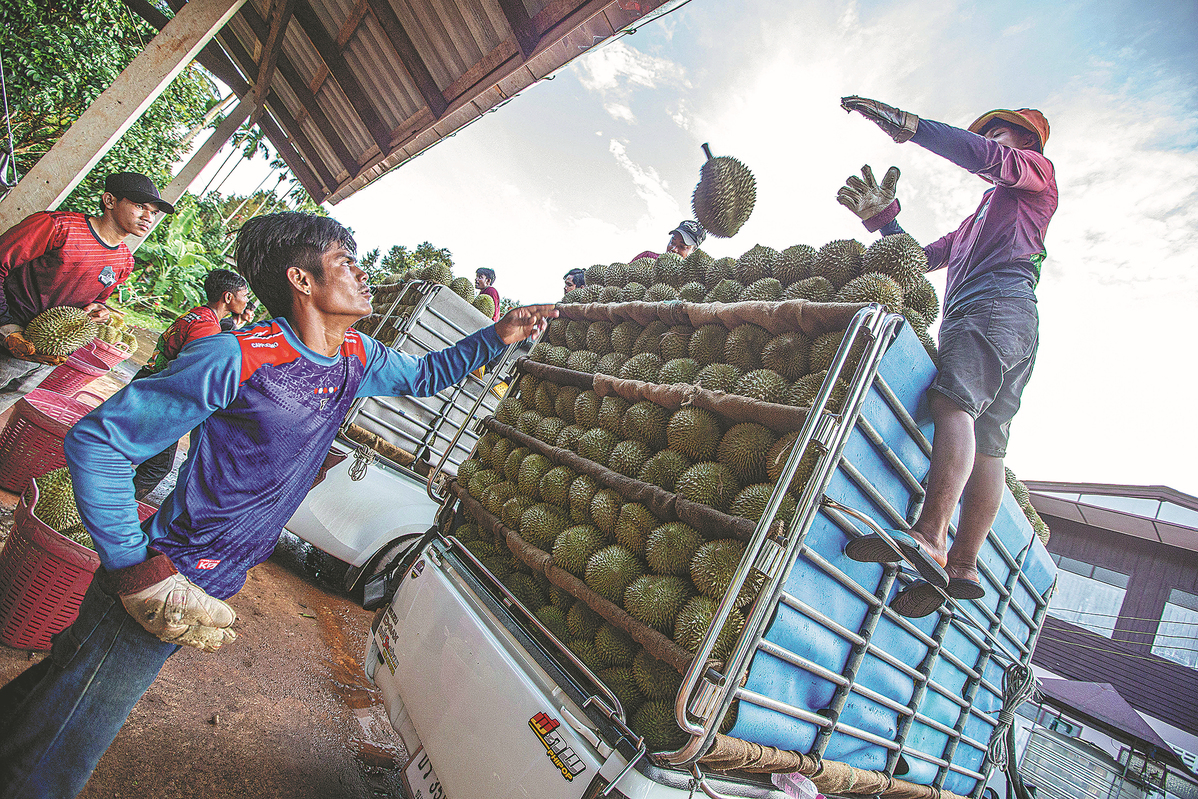China, ASEAN aim to strengthen relations

Passengers take a selfie with a model train of the Jakarta-Bandung High-Speed Railway at Halim Station in Jakarta, Indonesia, on Dec 17. The railway has delivered more than 700,000 passengers since its official commercial operation on Oct 17. XU QIN/XINHUA
Geographical proximity, combined with cultural, economic and diplomatic ties, reinforces bond among neighbors
Vianca Encarnacion believes that studying renewable energy engineering in China will allow her to help her home country, the Philippines, against climate change.
She was a survivor of super typhoon Haiyan 10 years ago and saw how it devastated her hometown, Tacloban city, in the central Leyte Province.
"I don't want (that disaster) to happen again," she said.
Encarnacion is one of 18 Filipino students who won a scholarship from Jiuquan Vocational Technical College in northwestern China's Gansu Province. The scholarship was made possible with the efforts of veteran environmental activist Wang Xiaojun.
"We need to send young talent from climate vulnerable countries (such as the Philippines) to be educated and trained, so that they can actually build a more climate-resilient future for themselves," said Wang, adding that China can provide such training because it is among the world's biggest developers of clean energy.
The scholarship program is just one of the many examples on how Chinese and Filipino citizens have joined hands to solve a pressing global challenge. More importantly, it shows how China and its nearest neighbors — Southeast Asian countries — have been building a community with a shared future for the past few years.
Experts said geographical proximity, combined with cultural, economic and diplomatic ties, has strengthened relations between China and the Association of Southeast Asian Nations.
"Community building in the ASEAN context is an endless process of understanding differences and similarities between ASEAN member states, stocktaking where our interests converge and diverge," Muhammad Habib Abiyan Dzakwan, a researcher from the Jakarta-based Center for Strategic and International Studies, said.
He said China is a stockholder in ASEAN's community-building efforts, noting how it has invested and helped ASEAN through the years. He cited China's accession to the Treaty of Amity and Cooperation in Southeast Asia, or TAC, on Oct 8, 2003. This made China the first among major countries to join the treaty and establish a strategic partnership with ASEAN.
By acceding to the TAC, China has elevated the value of the treaty as the "rule of the game" in the community-building process, Dzakwan said. China has also sent a signal to other ASEAN dialogue partners that the TAC is valuable and credible, encouraging them to accede to it as well, he added.
The TAC, launched in 1976, aims to uphold the principles of peaceful coexistence and friendly cooperation among ASEAN members.
In a forum held in Jakarta to mark the 20th anniversary of China's accession to the TAC, Hou Yanqi, Chinese ambassador to ASEAN, said in her closing remarks that it is "even more crucial to carry forward the spirit of the TAC today".
"We should firmly support ASEAN community building and its greater role in regional and international affairs instead of treating us as an arena for major power rivalry or forcing ASEAN to take sides," Hou said.
Korn Dabbaransi, former deputy prime minister of Thailand and current president of the Thai-Chinese Friendship Association, said the TAC is ASEAN's first legally binding instrument that stipulates universal principles on interstate relations and has served as a guide for ASEAN-China relations that are based on mutual trust, mutual respect and mutual benefit.
The treaty provides a "stable foundation upon which a closer ASEAN-China community with a shared future can be built", Korn told China Daily. The TAC serves as a code of conduct to enhance cooperation among peace-loving nations both within and outside ASEAN for maintaining regional peace and stability.
Beyond the TAC, Korn said relations between both sides have been enhanced by their decision to elevate bilateral ties to a comprehensive strategic partnership in 2021.
"The (comprehensive strategic partnership) has also contributed to the building of ASEAN Community and a wider region which is open, inclusive and sustainable," he said.
Under the comprehensive strategic partnership, ASEAN and China have reaffirmed the importance of maintaining ASEAN centrality in the evolving regional architecture; their mutual respect for each other's independence, sovereignty and territorial integrity; and their commitment to the open, free, inclusive, transparent and nondiscriminatory rules-based multilateral trading system.

Workers load freshly harvested durians at an orchard in Chumphon, Thailand, on Sept 18. China was the largest export market for Thai durians in 2022, accounting for more than 96 percent of the total export volume, Thailand's Ministry of Commerce said. WANG TENG/XINHUA
RCEP welcomed
Both sides also vowed to strengthen cooperation on climate change, biodiversity conservation, environmental protection, low-carbon solutions, clean energy, sustainable cities and rural development, and welcomed the Regional Comprehensive Economic Partnership, which entered into force on Jan 1, 2022.
As the world's biggest free trade agreement, the RCEP covers nearly one-third of the world's population and about 30 percent of its gross domestic product. The pact's signatories are the 10 members of ASEAN together with Australia, China, Japan, New Zealand and South Korea.
Lyu Daliang, spokesman for the General Administration of Customs of China, said the RCEP is one of the reasons behind the 15 percent increase in China-ASEAN trade in 2022.
"The effective implementation of the RCEP has brought trade creation effects and facilitated cooperation among industrial chains. Over the past year since the implementation of the RCEP, the policy dividends have continued to be unleashed, contributing to closer economic and trade exchanges among countries in the region. ASEAN is an important trade partner of China in the RCEP," Lyu said in a briefing in January last year.
In 2022, China's imports and exports with ASEAN reached $910 billion and accounted for 50.3 percent of China's total imports and exports with other RCEP members, he said.
Aleksius Jemadu, an international relations lecturer at the Universitas Pelita Harapan in Indonesia, said China and ASEAN have long been united by shared economic interests.
"Through the repeated practice of economic interdependence, the two sides go through process of mutual learning that will make them realize that they need each other," Jemadu told China Daily.
Even before the launch of the RCEP, ASEAN had been China's largest trading partner for a few years, the ASEAN Secretariat said. Trade volume between ASEAN and China has more than doubled from $235.5 billion in 2010 to $507.9 billion in 2019. China is also among the biggest sources of foreign direct investment for ASEAN, with inflows amounting to $15.4 billion in 2022.
The RCEP "has helped to connect China with ASEAN countries even closer", Thailand's Deputy Prime Minister and Minister of Commerce Phumtham Wechayachai said.
He appreciated China's efforts to promote the sustainable development of ASEAN, not only through the RCEP, but also through the Belt and Road Initiative. The BRI, which marks its 11th anniversary this year, has spurred an infrastructure boom and economic growth in the region.

Vehicles line up at a toll station on the Phnom Penh-Sihanoukville Expressway in Phnom Penh, Cambodia, on July 23. The first Chinese-invested expressway has been giving a significant boost to Cambodia's economic growth and tourism development. PPSHV EXPRESSWAY/XINHUA
Significant strides
"The economic integration between China and ASEAN has made significant strides over the past decades, which were marked by intensified collaboration within industrial and supply chains," Phumtham said.
China and ASEAN are also advancing negotiations of the 3.0 version of the ASEAN-China Free Trade Area, or ACFTA, this year, with a focus on incorporating new growth points in the digital and green economies, he said.
The ACFTA is ASEAN's oldest free trade pact among its dialogue partners. Current negotiations in ACFTA 3.0 cover different areas, including digital economy, green economy, supply chain connectivity, competition, consumer protection, and micro, small and medium enterprises.
Moving forward, experts said ASEAN-China relations are expected to endure despite tensions over the South China Sea, weaker global economic outlook and geopolitical conflicts.
Aloysius Lele Madja, a former Indonesian diplomat, said the future of ASEAN-China ties will depend on each party balancing their respective interests and how they each view the idea of shared prosperity and promoting global justice and peace.
Dzakwan said the relationship between the two parties will get stronger even amid external headwinds.
"Competition and disagreement, if not tensions, will undoubtedly take place. That is the consequence of living side-by-side as neighbors and the rise of both parties as leading economies," he said. "But the good thing about the ASEAN-China relationship is that we always manage to find our way of resolving disagreements and stabilize the relationship."
Photos
Related Stories
- Cambodia's export to other RCEP members up 23.6 pct in 9 months
- Top Chinese diplomat meets diplomatic envoys from ASEAN countries
- Hong Kong uniquely placed to add value to RCEP members: HKSAR chief executive
- Chinese pickles sail to Japan through RCEP
- China issues 19,834 certificates of origin under RCEP framework in November
- Ten years on, China's neighborhood diplomacy cements bonds, cooperation
Copyright © 2024 People's Daily Online. All Rights Reserved.









